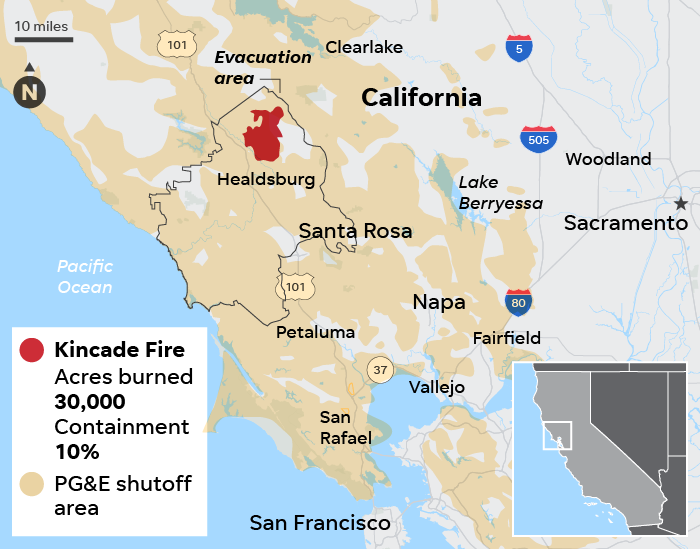Nearly 200,000 in Northern California flee their homes as historic winds fuel dangerous Kincade Fire – USA TODAY
In Northern California wine country, authorities ordered 2,000 people to evacuate as a wildfire burned 49 buildings and exploded to 25 square miles. Authorities said on Thursday night that the fire is 5% contained. (Oct. 25)
AP, AP
SAN FRANCISCO – Close to 200,000 Northern California residents, many of them left in the dark by a third power shutdown in a month, have been ordered to leave their homes as historic winds fueled an explosion of wildfires in the San Francisco Bay Area.
The state’s largest utility, Pacific Gas & Electric, shut off power to an estimated 2.3 million people across 38 counties starting Saturday evening in an effort to avoid having its equipment spark fires amid dry conditions and powerful winds. But the precautionary move did not prevent the Kincade Fire from igniting late Wednesday, and early indications point to malfunctioning PG&E equipment as the cause of it.
The blaze has now grown to 30,000 acres and was only 10% contained as of Sunday morning, forcing authorities to impose mandatory evacuations for 180,000 residents in Sonoma County, best known for its wine production.
Flames also flared up on both sides of Interstate 80 near the Carquinez Bridge in the city of Vallejo, 20 miles north of Oakland, forcing the freeway to be shut down in both directions and the nearby California State University Maritime Academy to be evacuated.
California Gov. Gavin Newsom declared a statewide emergency as the extreme weather conditions significantly heightened the risk of wildfires.
Concerns that the winds could blow embers and spread the Kincade Fire across a major highway prompted the evacuation orders covering parts of Santa Rosa, a city of 175,000 that was devastated by the Wine Country fires two years ago.
“This is the largest evacuation that any of us … can remember,” the Sonoma County Sheriff’s Office tweeted Sunday morning in English and Spanish, warning later that the winds were starting to whip up again.
The large expansion in the number of people told to leave their homes, from 90,000 Saturday night, reflected the increasingly dangerous conditions created by the winds picking up.
On Sunday morning, the National Weather Service reported wind gusts topped 90 mph in Healdsburg Hills North. Winds could lead to “erratic fire behavior” and send embers for miles, Cal Fire warned.
The wind event expected to peak early Sunday would likely be the strongest in several years, PG&E meteorologist Scott Strenfel said.
More than 3,000 firefighters with nearly 300 engines and 10 helicopters were battling the blaze, which had destroyed 79 structures. No fatalities have been reported.
PG&E equipment has been blamed for some of California’s deadliest and most destructive wildfires the last two years, and the utility acknowledged a broken jumper wire was found on a transmission tower near where the Kincade Fire started. The cause of the fire remains under investigation.
The company said this third wave of blackouts would affect about 940,000 homes and businesses for 48 hours or longer. Most of the impacted customers are in the Bay Area, along with some in the Sierra foothills.
The sheriff pleaded with residents in the evacuation zone to get out immediately, citing the 24 lives lost when fire swept through the region in October 2017. He thanked residents for heeding his call and praised the smooth exodus.
“Although I’ve heard people express concerns that we are evacuating too many people, I think those concerns are not valid at this point,” Essick said, noting that the winds pushed fire toward the towns of Healdsburg and Windsor overnight.
The Healdsburg area lost one of its historic attractions to the flames Sunday when embers carried by the winds sparked a blaze that engulfed the Soda Rock Winery whose buildings included a general store and post office founded in 1869. The winery was about 10 miles (16 kilometers) outside the town of Healdsburg.
In Southern California, which was was also the subject of preventive outages late last week, the Santa Clarita fire
Contributing: The Associated Press





